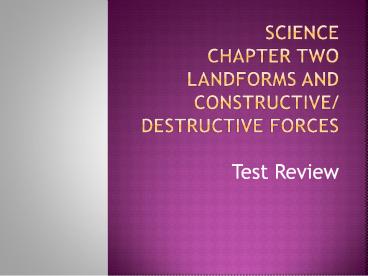Science Chapter Two Landforms and Constructive/ Destructive Forces - PowerPoint PPT Presentation
Title:
Science Chapter Two Landforms and Constructive/ Destructive Forces
Description:
Title: Science Chapter Two Landforms and Constructive/Destructive Forces Author: Shannon Surrency Last modified by: Shannon Surrency Created Date – PowerPoint PPT presentation
Number of Views:298
Avg rating:3.0/5.0
Title: Science Chapter Two Landforms and Constructive/ Destructive Forces
1
Science Chapter TwoLandforms and
Constructive/Destructive Forces
- Test Review
2
What is a natural land shape or feature, such
as mountains, plains, or valleys?
- a landform
3
What is a hill of sand, made and shaped by wind?
- A sand dune
4
What is an area of new land at the mouth of a
river, formed from sediments carried by the river?
- A delta
5
What is a break in the earths crust?
- A fault
6
What is a mountain that forms as molten rock
flows through a crack onto the earths surface
- A volcano
7
What is melted, or molten rock beneath Earths
surface?
- Magma
8
What is molten rock that reaches Earths surface?
- lava
9
What is a movement of the ground caused by a
sudden release of energy in the earths surface?
- An earthquake
10
What is a machine that records movement in the
earths crust?
- A seismograph
11
What is dropping, or depositing, sediment into a
new location?
- deposition
12
What is the process of moving sediment by wind,
moving water, or ice?
- erosion
13
What is the process of wearing away rocks by
natural means?
- weathering
14
What can stop the flow of a river?
- A dam
15
What is a wall of earth or concrete built along
the banks of a waterway?
- A levee
16
What surface features are caused by CONSTRUCTIVE
processes?
- Sand dunes
- Canyons (Grand Canyon)
- Mesas
- Sandbars
- Deltas
17
What causes a delta to form?
- Deltas form at the mouth of a river and are
formed when a river slows down and deposits
sediment that it has carried.
18
What can reshape sand dunes?
- Wind and ocean waves
19
What causes a mesa to form?
- Wind and water wearing down the rock
20
Surface features can be changed by destructive
processes - What changes can be caused by wind?
- Wind will wear away rock over time by blowing
sand against it. This is an example of
weathering. - Wind moves sand and reshapes sand dunes. This is
an example of erosion.
21
Surface features can be changed by destructive
processes - What changes can be caused by water?
- Canyons are formed by rushing water
- Sediment gets carried from one place to another
- Ocean waves change and wear down cliffs
- Ocean waves change beaches
- Rain that freezes in small cracks can expand and
break down rock - Flowing water makes rocks tumble together, which
smoothes their edges
22
Surface features can be changed by destructive
processes - What changes can be caused by plants?
- Plants can cause weathering
- Roots can grow into the cracks of rocks and as
they grow, the rock can break this is an
example of weathering - Plants can be helpful by their roots holding soil
and sand in place to prevent erosion
23
- What are the four layers of the earth?
- Crust, mantle, outer core, inner core
- What is the thinnest layer?
- Crust
- Is the inner core solid or liquid?
- Solid because of the pressure
24
Are earthquakes and volcanoes constructive,
destructive, or both?
- both
25
What types of plate movement causes earthquakes?
- Plates pushing together, plates sliding past each
other, and plates pulling apart.
26
Where do MOST earthquakes happen?
- Along a fault
27
How are mountains formed?
- Mountains are formed when the crust folds,
cracks, and bends upward because of the movement
of Earths plates. - Mountains are also formed by volcanoes.
28
What is a volcanic mountain made from?
- A volcano is a mountain made of lava, ash, or
other materials from eruptions.
29
What causes volcanoes to form?
- Volcanoes occur when hot molten rock, called
magma, pushes up through an opening in the Earth.
When the magma reaches the Earths surface, it
is called lava and it can harden into a mountain.
30
What formed the Hawaiian Islands?
- volcanoes
31
What can earthquakes form?
- Mountains and lakes
32
How are earthquakes destructive?
- They can damage roads, bridges, houses, and other
buildings
33
What do scientists use to study where earthquakes
have happened and where they are likely to happen?
- seismographs
34
Why do scientists study earthquakes?
- So they can use their data to make buildings
stronger, to predict where they might happen in
the future, and to help prevent or minimize
damage that they do which will help to improve
lives
35
What structures are used to help prevent
flooding?
- Dams and levees
36
How can dams help prevent flooding?
- They can hold back water that would normally rush
down stream and rivers during heavy rainfall.
37
How can levees help to prevent flooding?
- They are built up along the sides of rivers to
keep rising floodwaters inside of the channel of
a river or stream.
38
What is beach restoration or recalmation?
- When beaches are restored by moving sand from one
location to another
39
Why do we restore beaches?
- Because ocean waves cause beach erosion (when
sand is moved from one area to another by the
waves)































